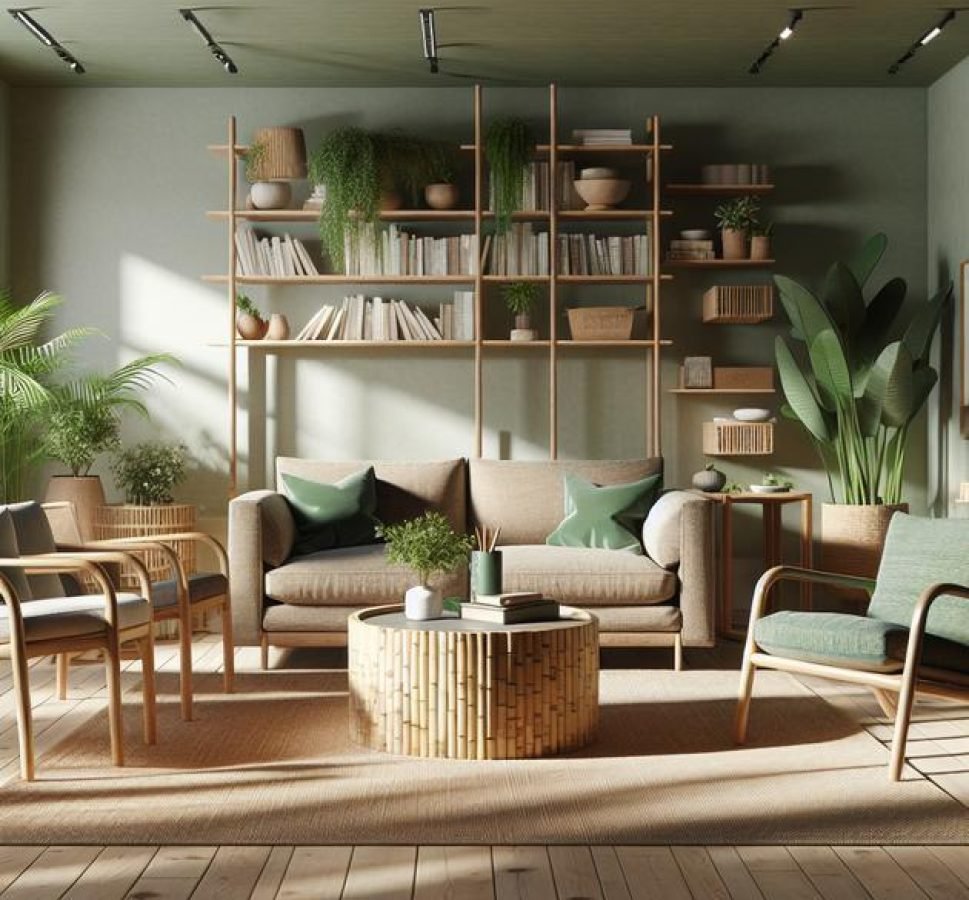Sustainable furniture brands prioritize eco-friendly materials, ethical production, and durable designs to reduce environmental impact and promote responsible consumption.
Have you ever wondered how sustainable furniture brands really affect your living space and the environment? It’s not just about looks—these brands tell a deeper story of care and responsibility, inviting us to rethink what we bring home.
what makes furniture truly sustainable
Sustainable furniture is more than just eco-friendly materials; it represents a commitment to reducing environmental impact throughout its lifecycle. At the core, it starts with responsible sourcing, using renewable, recycled, or reclaimed materials that minimize deforestation and waste. For example, furniture made from FSC-certified wood ensures the trees come from responsibly managed forests.
Durability and longevity are key factors. Sustainable pieces are designed to last, reducing the need for frequent replacements that generate excess waste. This contrasts with cheaper, mass-produced furniture that often ends up in landfills.
The manufacturing process also matters. Brands dedicated to sustainability often use non-toxic finishes and adhesives, minimizing harmful emissions and protecting both workers and customers. Energy-efficient production and locally made products help lower the carbon footprint further.
Finally, a true sustainable furniture piece considers the end of its life cycle. It should be easy to repair, refurbish, and ultimately recycle or biodegrade. This circular approach helps close the gap on waste and encourages mindful consumption.
In essence, truly sustainable furniture combines ethical material choices, thoughtful design, and responsible manufacturing practices to create products that respect people and the planet.
overview of popular sustainable furniture brands
Several popular sustainable furniture brands have set the standard for eco-friendly design and responsible production. Companies like IKEA have launched lines focused on using renewable materials and reducing carbon footprints. Their commitment to sustainability includes sourcing wood from responsibly managed forests and incorporating recycled materials.
West Elm is known for blending modern style with sustainability, offering furniture made from FSC-certified wood and organic fabrics. They emphasize fair trade practices, supporting artisans around the world.
Herman Miller takes innovation further by creating highly durable designs that use recycled and recyclable materials. Their products often feature modular components, making repair and refurbishment easier.
Made Trade curates collections that showcase handcrafted items made from sustainable or reclaimed resources. Their focus on transparency ensures consumers understand the social and environmental impact behind each product.
Other noteworthy brands include Burrow, with its eco-friendly upholstery and minimal waste packaging, and Medley, which offers customizable furniture crafted with non-toxic finishes and natural fibers.
Together, these brands highlight different ways sustainability can be integrated—from raw materials to manufacturing processes and social responsibility—helping consumers make informed and ethical choices.
materials commonly used in eco-friendly furniture
Eco-friendly furniture relies heavily on materials that minimize environmental impact while offering durability and aesthetic appeal. Wood is the most commonly used material, especially when it is reclaimed, reclaimed, or sourced from sustainably managed forests certified by organizations like FSC.
Another popular material is bamboo, known for its rapid growth and renewability. Bamboo creates strong, lightweight furniture and requires fewer resources compared to traditional hardwoods.
Recycled metals, like aluminum and steel, are frequently used in frames and accents. These metals reduce the demand for virgin resources and often come from post-consumer waste.
Natural fibers, such as jute, hemp, and organic cotton, are preferred for upholstery and textiles. They avoid harmful chemicals used in synthetic options and biodegrade more easily.
Eco-friendly finishes and adhesives are essential to sustainable furniture, preventing toxic off-gassing. Brands often use water-based stains, natural oils, and formaldehyde-free glues to ensure safety for both people and the environment.
Finally, reclaimed materials like old wood or metal give new life to discarded resources, creating unique pieces that tell a story and reduce landfill waste.
how sustainable brands impact the environment

Sustainable furniture brands play a crucial role in reducing negative environmental impacts. By prioritizing responsible sourcing, they help protect forests and decrease deforestation. Using certified wood and recycled materials lowers waste and conserves natural habitats.
These brands also focus on reducing carbon footprints during manufacturing by employing energy-efficient processes and minimizing emissions. Many choose local production to cut down transportation pollution and support local economies.
Waste reduction is another key factor. Sustainable brands design products to last longer, repair easily, and encourage recycling or upcycling. This approach prevents excessive furniture disposal in landfills.
Moreover, using non-toxic, water-based finishes and adhesives improves indoor air quality and reduces harmful chemical release into the environment. Sustainable brands often incorporate circular economy principles, closing resource loops and promoting reuse.
Overall, these efforts combine to limit pollution, conserve resources, and promote healthier ecosystems, demonstrating how sustainable furniture brands positively impact the environment.
importance of sourcing local materials
Sourcing local materials is a cornerstone of sustainable furniture production, significantly reducing environmental impact. When brands use materials sourced close to manufacturing sites, they minimize transportation distances, which lowers carbon emissions and energy consumption.
Supporting local economies is another vital benefit. Purchasing materials from local suppliers helps create jobs and sustain communities, fostering a more resilient and transparent supply chain.
Local materials also tend to reflect the natural environment of the area, offering unique textures and qualities that add character to furniture. This reduces reliance on imported resources that may involve harmful extraction practices abroad.
Sustainability is enhanced because local sourcing allows for better quality control and quicker responses to supply chain issues. It also encourages circular economies by facilitating the reuse and recycling of regional byproducts.
Overall, prioritizing local materials contributes to eco-friendly practices while building meaningful connections between producers and communities.
design trends in sustainable furniture
Sustainable furniture design trends focus on blending style, function, and eco-consciousness. A growing preference for minimalist and timeless designs helps reduce waste by encouraging pieces that remain fashionable for years.
Natural materials like wood, bamboo, and cork continue to dominate, often paired with organic textiles and recycled metals. These choices highlight a connection to nature and promote a sense of warmth and comfort.
Modular and multifunctional furniture is increasingly popular, allowing users to adapt pieces to various spaces and needs. This flexibility helps extend the furniture’s lifespan and reduces the need for excess buying.
Upcycling and reclaimed material usage are key trends, giving old items a fresh look while lowering demand for new resources. Many designers incorporate visible signs of reuse to celebrate sustainability.
Colors inspired by nature, such as earth tones and muted greens, create calming interiors and complement eco-friendly materials. Additionally, handcrafted details and artisanal techniques add unique character and support ethical craftsmanship.
Overall, these trends reflect a shift toward furniture that is not only beautiful and functional but also kind to the planet.
how to verify a brand’s sustainability claims
Verifying a brand’s sustainability claims is essential to ensure that you are supporting genuinely eco-friendly furniture makers. Start by checking for third-party certifications like FSC, Cradle to Cradle, or GREENGUARD. These labels indicate that a brand’s practices meet recognized environmental and health standards.
Review the company’s transparency by exploring their website or reports on sourcing, manufacturing, and labor practices. Sustainable brands usually provide detailed information about their materials and supply chain.
Look for customer reviews and expert opinions related to the brand’s environmental impact. Independent blogs, industry watchdogs, and sustainability forums can provide honest insights.
Question vague or broad claims such as “eco-friendly” or “green” without backing data. Authentic brands use specific facts, numbers, and certifications to support their statements.
Assess whether the brand participates in circular economy initiatives like take-back programs, repair services, or recycling efforts. These actions show a commitment beyond just marketing.
By being an informed buyer and verifying claims carefully, you help promote transparency and encourage better industry standards for sustainable furniture.
benefits of buying furniture from ethical brands

Buying furniture from ethical brands offers numerous benefits that extend beyond just owning a beautiful piece. These brands prioritize fair labor practices, ensuring workers receive fair wages and safe working conditions. This helps promote social justice and improves lives globally.
Ethical brands also focus on environmentally friendly materials and processes. By choosing their products, consumers support reduced deforestation, lower pollution, and less waste in the furniture industry.
Quality is often higher with ethical brands because they invest in craftsmanship and durable materials. This means your furniture lasts longer, saving you money and reducing environmental impact over time.
Shopping ethically encourages transparency and accountability in the market, motivating more companies to improve their practices. It also provides peace of mind knowing your purchase aligns with values of sustainability and fairness.
Finally, many ethical brands give back to communities or support conservation efforts, adding positive social and environmental impacts beyond just the furniture itself.
price considerations for sustainable furniture
When considering sustainable furniture, price is a key factor that reflects the quality, materials, and ethical practices behind each piece. Sustainable furniture often has a higher upfront cost due to the use of eco-friendly materials, skilled craftsmanship, and fair labor wages.
However, investing in sustainable pieces can save money over time because of their durability and long lifespan. Cheaper furniture may need frequent replacement, which adds up and contributes to waste.
Other cost factors include the brand’s commitment to transparency and certifications, which can increase production expenses but offer assurance about environmental impact.
Customization and local production can also affect prices. Custom pieces or those made locally often cost more but reduce transportation emissions and support community economies.
It’s important to weigh initial costs against long-term benefits, valuing sustainability and quality over quick affordability. This mindset helps promote more responsible consumer choices and a healthier planet.
stories behind leading sustainable furniture brands
Many leading sustainable furniture brands have inspiring stories rooted in passion for the environment and ethical craftsmanship. For instance, West Elm began with a mission to support artisans worldwide, combining modern design with fair trade and sustainability, promoting both community well-being and eco-conscious practices.
Herman Miller transformed furniture manufacturing by integrating sustainability into innovation, emphasizing products designed to last and be easily repaired. Their commitment reflects decades of pioneering efforts in reducing environmental impact.
IKEA shifted gears towards sustainability by launching programs focused on renewable materials, energy efficiency, and circular economy initiatives. Their scale allows widespread influence on global furniture consumption patterns.
Smaller brands like Medley focus on non-toxic materials and customizable designs, with stories centered on transparency and a desire to create truly healthy homes.
These brands’ stories showcase how environmental responsibility, social equity, and quality craftsmanship can come together to shape the future of furniture.
how craftsmanship reflects sustainability
Craftsmanship plays a vital role in reflecting sustainability within the furniture industry. Skilled artisans focus on quality over quantity, creating durable pieces designed to last for many years. This intentional approach reduces waste and the demand for constant replacements.
Traditional techniques often use natural and non-toxic materials, avoiding harmful chemicals found in mass-produced furniture. Handcrafted items can also incorporate reclaimed wood and recycled components, giving new life to old resources.
Detailed workmanship ensures that every joint and finish is carefully made, allowing furniture to be repaired easily rather than discarded. This repairability supports a circular economy and extends product life.
Artisan-made furniture often tells a story through its unique design, representing cultural heritage and sustainable values. This connection fosters a deeper appreciation and mindfulness in consumers about their purchases.
Ultimately, craftsmanship reflects sustainability by emphasizing ethical production, resource conservation, and timeless value in furniture design.
customization and sustainable furniture

Customization in sustainable furniture offers consumers the opportunity to create pieces that fit their needs while minimizing waste. By allowing design choices tailored to specific spaces and preferences, furniture is less likely to be discarded due to poor fit or style mismatch.
Made-to-order production reduces excess inventory and overproduction, which are significant sources of waste in the furniture industry. This approach ensures that materials are used efficiently and only when needed.
Customization also extends to material selection, enabling buyers to choose eco-friendly options like reclaimed wood, organic fabrics, or low-impact finishes. This enhances the piece’s sustainability by reflecting personal values.
Additionally, furniture designed for easy disassembly allows parts to be replaced or upgraded, further prolonging its life and reducing environmental impact.
Overall, customization promotes mindful consumption and supports sustainable practices by reducing waste, encouraging quality, and honoring individual style.
recycling and upcycling in furniture design
Recycling and upcycling are fundamental practices in sustainable furniture design that reduce waste and extend the life of materials. Recycling involves processing old materials to create new furniture components, reducing the need for virgin resources. Common recycled materials include metal, glass, and certain plastics.
Upcycling takes a creative approach, transforming discarded furniture or materials into new, often more valuable pieces. This process preserves the original item’s character while preventing it from ending up in landfills.
Designers use reclaimed wood, fabric scraps, and repurposed metal to craft unique furniture that tells a story. These pieces often feature visible signs of reuse, such as natural wear or mixed textures, emphasizing their eco-friendly nature.
Both recycling and upcycling contribute to a circular economy, promoting resource efficiency and reducing environmental impact. They encourage consumers to think differently about waste and the value of materials.
By embracing these practices, sustainable furniture brands help conserve resources and inspire a culture of mindful consumption.
tips for maintaining sustainable furniture
Maintaining sustainable furniture properly helps extend its life and preserve its eco-friendly benefits. Start by keeping furniture clean using gentle, natural cleaners instead of harsh chemicals that can damage finishes or release toxins.
Regular dusting and wiping with a soft cloth prevent dirt build-up and scratches. For wooden pieces, apply natural oils like linseed or beeswax periodically to nourish the wood and maintain its texture.
Avoid placing furniture in direct sunlight or near heat sources to prevent warping, discoloration, or cracking. These simple steps protect the materials and preserve their appearance.
If upholstery becomes stained, spot clean immediately with water-based cleaners safe for the fabric. For deep cleaning, follow manufacturer recommendations to avoid damage.
Repair and refurbish any minor damages instead of replacing entire pieces. Tightening screws, gluing joints, or reupholstering cushions are eco-friendly ways to keep furniture functional and beautiful.
By caring mindfully for sustainable furniture, you contribute to reducing waste and enjoying quality, long-lasting pieces in your home.
future trends in eco-conscious furniture
Future trends in eco-conscious furniture emphasize innovation, sustainability, and adaptability. Advances in biodegradable and plant-based materials are expected to gain popularity, offering alternatives that minimize environmental harm at the end of a product’s life.
Smart technologies are being integrated into furniture design to improve energy efficiency and user experience. For instance, adjustable lighting, charging stations, and connectivity features aim to blend comfort with sustainability.
Modular and multi-functional furniture will continue to grow in demand, reflecting modern lifestyles and smaller living spaces. These designs reduce the need for excess furniture and encourage long-term use.
There is also a rising interest in circular economy models, where brands offer buy-back, repair, or recycling services. This approach helps close resource loops and reduce landfill waste.
Design aesthetics will likely shift toward timeless styles that promote durability and resist the fast furniture trend. Additionally, increasing transparency and consumer involvement in the supply chain will boost brand trust.
Overall, the future of eco-conscious furniture combines cutting-edge materials, technology, and ethical practices to create sustainable living environments.
Wrapping Up Sustainable Furniture Choices
Choosing sustainable furniture brands is a smart way to support the planet and enjoy high-quality, beautiful pieces. These brands focus on using eco-friendly materials, ethical practices, and innovative designs that last longer and reduce waste.
By understanding materials, manufacturing processes, and verifying sustainability claims, you can make informed decisions that benefit both your home and the environment. Customization, maintenance, and embracing future trends also help maximize the value and impact of your sustainable furniture.
Ultimately, supporting sustainable furniture means investing in a healthier planet and a more responsible way of living. Every choice matters and can inspire change in the industry.





